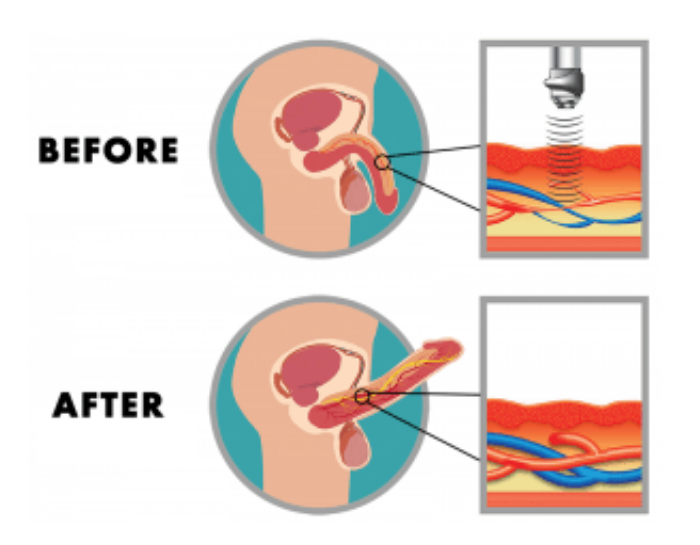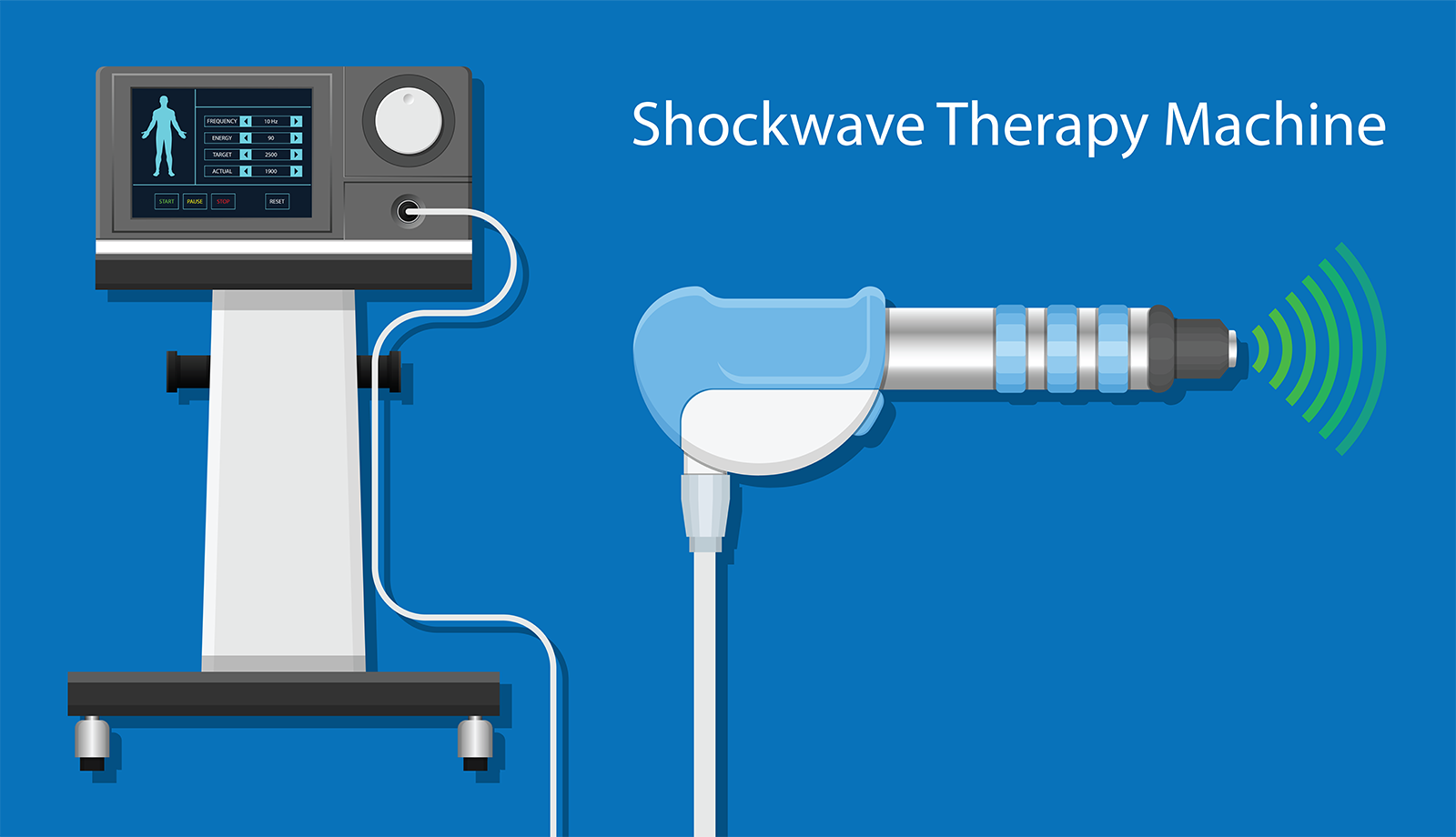English
Erectile dysfunction (ED) is a very common health problem that affects a large proportion of men. The word “40 over 40” stands true. Various causes leading to various treatments for ED have been highlighted and adopted respectively. Most, if not all, are situational and not permanent ( apart from modifying lifestyle and care about Men’s health).
Regenerative therapies for ED
Therefore, additional treatments are being investigated, including regenerative therapies. Regenerative therapies aim to restore function via replacement or regeneration of human cells, tissues, or organs. Regenerative therapies for the treatment of ED include low-intensity extracorporeal shockwave therapy (Li-ESWT).
Benefits of Li-ESWT
Li-ESWT began to be explored as an alternative means of treating ED,33 with the first randomized controlled trial (RCT) published in 2012. The benefits of Li-ESWT stems from its ability to induce microtrauma. A shockwave is a type of longitudinal acoustic wave that is composed of three sequential parts: a short pulse, a rapid increase to max positive acoustic pressure (the “shock”), and a prolonged period of negative pressure.

Stem Cell Therapies (SCT)
On the other hand, stem cell therapies (SCT) seek to harness the regenerative potential of stem cells for the repair of injured or damaged tissues. The utilization of adult stem cells has allowed for easier access to stem cells, leading to a higher likelihood of utility in regenerative medicine.
Since the causes of ED are numerous and include damage to the neurovascular bundle or neuropraxia during radical prostatectomy nerve damage, endothelial dysfunction, and oxidative stress in the setting of diabetes mellitus, SCT has gained a lot of interest in this field.
As opposed to PRP, several studies have evaluated the efficacy of SCT for the treatment of ED in humans, with promising results.
The combination of Li-ESWT and SCT in ED is an emerging concept. For stem cells to reach the affected tissues, and to accept their actions via paracellular and intercellular signals, they have to be “led” to the affected tissues. One method is to induce an acute micro-trauma to the targeted tissues allowing them to release their attractive signals for the relating cells, of more importantly here, the stem cells, to accumulate in that particular area and exceed their restorative tasks. Animal studies have already proven this concept. Human trials are awaited. Food for thought..
Reference : journals.sagepub
Arabic
Li-ESWT مع الطب التجديدي في الضعف الجنسي
ضعف الانتصاب (ED) هو مشكلة صحية شائعة جدًا تؤثر على نسبة كبيرة من الرجال. كلمة “40 فوق 40” صحيحة. تم تسليط الضوء على الأسباب المختلفة التي أدت إلى علاجات مختلفة للضعف الجنسي واعتمادها على الاسباب. معظمها ، إن لم يكن كلها ، ظرفية وليست دائمة (بصرف النظر عن تعديل نمط الحياة والاهتمام بصحة الرجل).
لذلك ، يتم التحقيق في علاجات إضافية ومستديمة ، بما في ذلك العلاجات التجديدية. تهدف العلاجات التجديدية إلى استعادة الوظيفة عن طريق استبدال أو تجديد الخلايا أو الأنسجة أو الأعضاء البشرية. تشمل العلاجات التجديدية لعلاج الضعف الجنسي علاجًا منخفض الكثافة بالموجات الصدمية خارج الجسم (Li-ESWT).
بدأ استكشاف Li-ESWT كوسيلة بديلة لعلاج الضعف الجنسي ، مع أول تجربة ذات ادله (RCT) نُشرت في عام 2012. تنبع فوائد Li-ESWT من قدرته على إحداث الصدمات الدقيقة. موجة الصدمة هي نوع من الموجات الصوتية الطولية التي تتكون من ثلاثة أجزاء متتالية: نبضة قصيرة ، وزيادة سريعة إلى أقصى ضغط صوتي إيجابي (“الصدمة”) ، وفترة طويلة من الضغط السلبي.
من ناحية أخرى ، تسعى علاجات الخلايا الجذعية (SCT) إلى تسخير الإمكانات المتجددة للخلايا الجذعية لإصلاح الأنسجة المصابة أو التالفة. توجيه استخدام الخلايا الجذعية البالغة بالوصول السهل إلى الخلايا الجذعية ، يؤدي إلى زيادة احتمالية الاستفادة منها في الطب التجديدي.
نظرًا لأن أسباب الضعف الجنسي عديدة وتشمل تلف الحزمة الوعائية العصبية أو الأعصاب أثناء تلف الأعصاب الجذري للبروستاتا ، والخلل البطاني ، والإجهاد التأكسدي في حالة مرض السكري ، اكتسبت SCT الكثير من الاهتمام في هذا المجال.
على عكس PRP ، قيمت العديد من الدراسات لفعالية SCT في علاج الضعف الجنسي لدى البشر ، مع نتائج واعدة.
يعتبر الجمع بين Li-ESWT و SCT في ED مفهومًا ناشئًا. لكي تصل الخلايا الجذعية إلى الأنسجة المصابة ، وباستثناء أفعالها عبر الإشارات بين الخلايا والداخلية ، يجب “توجيهها” إلى الأنسجة المصابة. تتمثل إحدى الطرق في إحداث صدمة صغيرة حادة للأنسجة المستهدفة مما يسمح لها بإطلاق إشاراتها الجذابة للخلايا ذات الصلة ، والأهم من ذلك ، الخلايا الجذعية ، لتتراكم في تلك المنطقة بالذات وتتجاوز مهامها التصالحية. لقد أثبتت الدراسات التي أجريت على الحيوانات بالفعل هذا المفهوم.

